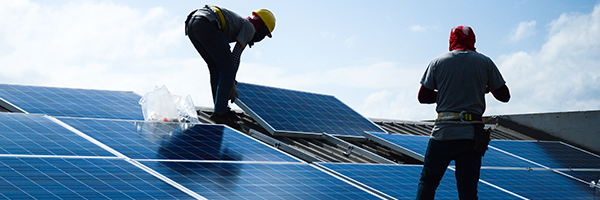
December 14, 2023 | Daily JAM, Jubak Picks, RUN, SEDG, Stock Alerts |
Among today’s big stock market winners today: SolarEdge Technologies (SEDG), the biggest maker of inverters used in turning sunlight into electricity, closed up 16.67%, and Sunrun (RUN), a leader in the installation of residential solar systems, closed up 19.92%. This rally had absolutely nothing to do with any news out of the recently ended COP28 United Nations Climate Conference. It was a pure reaction to the signs in yesterday’s Dot Plot from the Federal Reserve that the central bank was looking to cut interest rates at least three times in 2024. Makes perfect sense.

July 7, 2023 | Daily JAM, Millennial, SEDG, Top 50 Stocks |
This breakthrough in solar power isn’t enough to stop global warming by itself, but it sure is enough to upend the entire energy sector within the next five years. Multiple research groups (and “multiple’ is important here because it means there’s more likelihood that the lab results will hold up to scrutiny. Two groups published the details of their efficiency breakthroughs in the journal Science on Thursday, and at least two others are known to have pushed well beyond 30%.) have reported a breakthrough that will push the efficiency with which solar cells convert sunlight to electricity through the 30% level that has been thought to mark the maximum conversion of sunlight to electricity.

June 22, 2023 | Daily JAM, GNRC, Short Term, Volatility |
I’ve got major questions about Generac’s (GNRC) long-term growth. The company, the dominant player in the market for residential backup electric generators (with about 4 times the market share–or about 75% of the market–of its nearest competitor) faces big questions, in my opinion, about its long-term strategy and its ability to grab significant revenue in the clean energy market where it faces competition from larger companies, more established in the market, such as SolarEdge (SEDG) and Enphase (ENPH). But in the short run? Say, the next two or maybe three (at the outside) months, I say this is a stock that will ride summer storms and heat waves to gains. Especially, if as I project, the company delivers lackluster quarterly earnings when it reports on August 2, but gives very positive guidance for the next quarter or two

May 2, 2022 | CMI, Daily JAM, DNNGY, ES, FQVLF, JCI, LICY, Long Term, SCCO, Special Reports, Top 50 Stocks |
All you have to do to find the high profits that will make the risk of investing in climate change stocks worthwhile is to focus on sectors (1) where the rewards are solid and the risk is quantifiable, (2) where companies are making profit the old-fashioned way by building out networks and then charging high rents to use them, by (3) carefully targeting a few technologies (wind and solar and hydrogen and electric cars) that will be part of any mix of solutions, and (4) by investing in bottlenecks that are likely to drive prices up (and provide good profits for companies that resolve the bottleneck.

February 28, 2022 | Daily JAM, Special Reports |
In this New Market you need stocks like the 10 picks in my New Edge Portfolio to supplement the 10 solid winners of the New Core Portfolio with which I kicked off the first part of this Special Report: 10 stock picks for a New Core Portfolio for New Market. And watch out for Part 3 coming this week

December 20, 2021 | Daily JAM, Short Term |
I’ve learned over the years never to think that a piece of legislation is dead until I’ve seen its proponents cut off its head and bury it at a cross roads with garlic around its neck and a stake through its heart. But I’d certainly entertain the idea that the Biden administration’s Build Back Better plan is dead at the hands of West Virginia Democratic Senator Joe Manchin. And that defeat for Build Back Better means a huge set back in efforts to put the U.S. economy on the right side of the battle to temper global climate change. So today’s sell off of companies looking toward federal spending to accelerate growth in those sectors makes perfect sense. Other “Green” stock either didn’t fall or actually rose because growth for those companies isn’t dependent on government subsidies.

October 26, 2021 | Daily JAM |
My Special Report for how to Buy on the Dip, What to Buy on the Dip and When to Buy on the Dip moves on with today’s installment to Strategy #2 and picks # 5, #6, and #7. Strategy #2 and Picks: By stocks that have already been hammered by 20% or more and that have just put in bottoms. They could fall more in a general market retreat, but the big risk is out of these shares.

October 25, 2021 | AMSC, CHPT, Daily JAM, ES, RUN, SEDG |
I’m starting up my videos on JubakAM.com again–this time using YouTube as a platform. My sixty-third YouTube video “Trend of the Week: Alternative Energy Stocks” went up today.

October 21, 2021 | Daily JAM |
I’m starting up my videos on JubakAM.com again–this time using YouTube as a platform. My sixty-first YouTube video “3 Picks for a Market That’s Grinding Higher” went up today.

October 18, 2021 | AMAT, AMD, AMSC, ASML, Daily JAM, EVGO, F, FCX, Jubak Picks, Mid Term, Millennial, NJDCY, NVDA, SEDG, Special Reports, TSLA, Volatility, VWAPY |
Yes, we want to buy on the dip. Whenever we get a significant dip. (And significant to me is 5% or more in the major indexes–and 10% or more in specific sectors.) But, we need new strategies for buying on the dip that take into account the market’s valuation problem, the central bank tightening that looks to be in the cards, and the real possibility of a dip in growth below forecasts in 2022. I’ve got fouir strategies to suggest for buying in this market on these dips. And 14 picks to use to execute those strategies.

August 10, 2021 | ALB, AMSC, CAT, Daily JAM, DE, Mid Term, MLM, Morning Briefing, VMC |
The $1.2 trillion infrastructure bill that the Senate passed today–roughly half of that represents new spending–still faces a tough go in the House of Representatives where progressive Democrats have criticized the measure as light on dollars to fight global climate change. That spending has been pushed into a second infrastructure bill, which would also include money for expanding Medicare and improving access to childcare among other “social” infrastructure spending, which the Senate actually took up today. Most political pundits think that efforts to pass a “social” infrastructure bill using reconciliation will be enough to secure all the votes needed to pass the traditional infrastructure bill in the House. The bill passed today would include more than $110 billion to replace and repair roads, bridges and highways, and $66 billion to boost passenger and freight rail. The plan includes an additional $55 billion to address problems in the U.S. water supply such as continued use of lead pipes despite conclusive evidence that lead in water pipes leads to cognitive impairment in children. It allocates $65 billion to modernize the country’s power grid and $7.5 billion to build out a national network of electric-vehicle charging stations. The bill earmarks $47 billion to respond to wildfires, droughts, coastal erosion, heat waves and other climate crises.

May 17, 2021 | Daily JAM, Dip-O-Meter, IFNNY, Jubak Picks, NVDA, NXPI, PYPL, RUN, SEDG, Top 50 Stocks |
Last week’s sell off and rally, which left the Standard & Poor’s 500 down 1.4% for the week, resulted in farther dips in many of the Dip-O-Meter stocks. The picture that emerges is much more complicated than simple advice to “Buy on this dip.”












